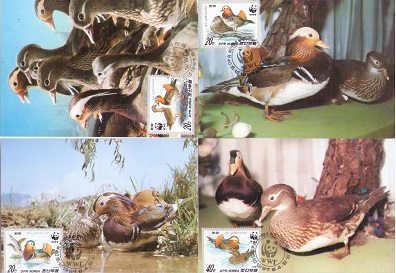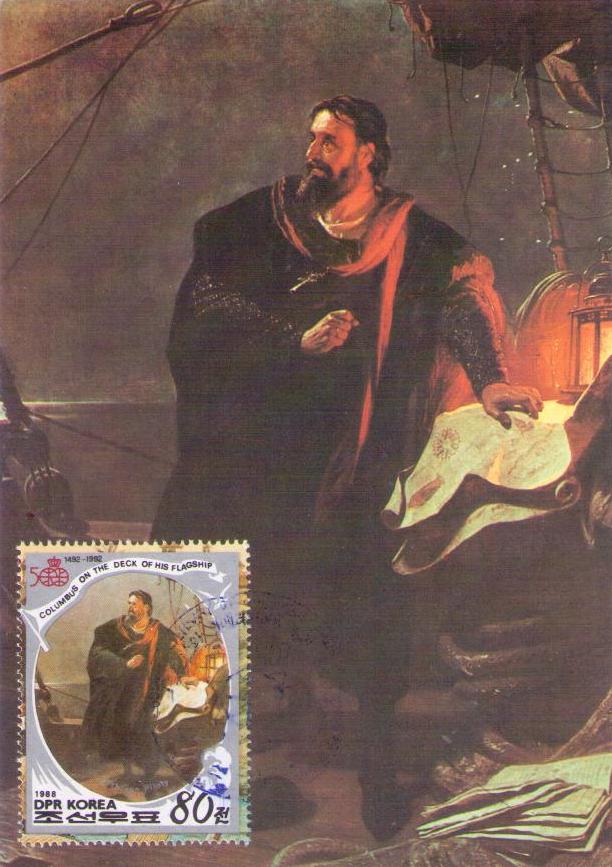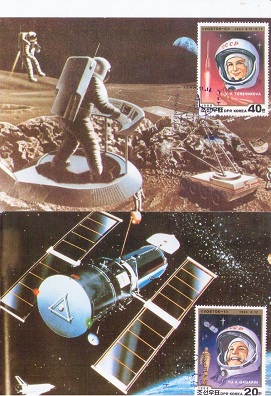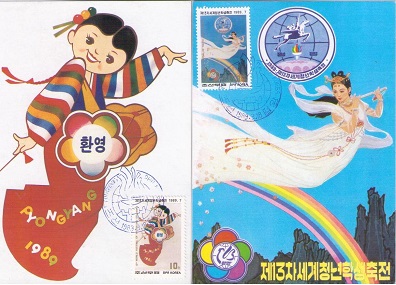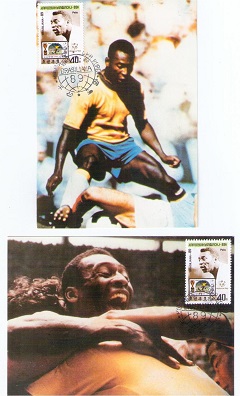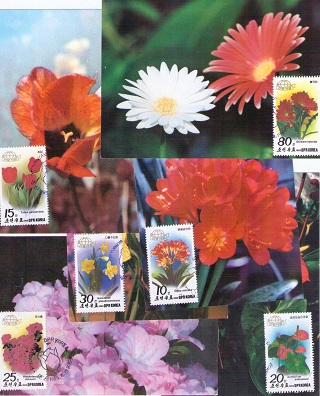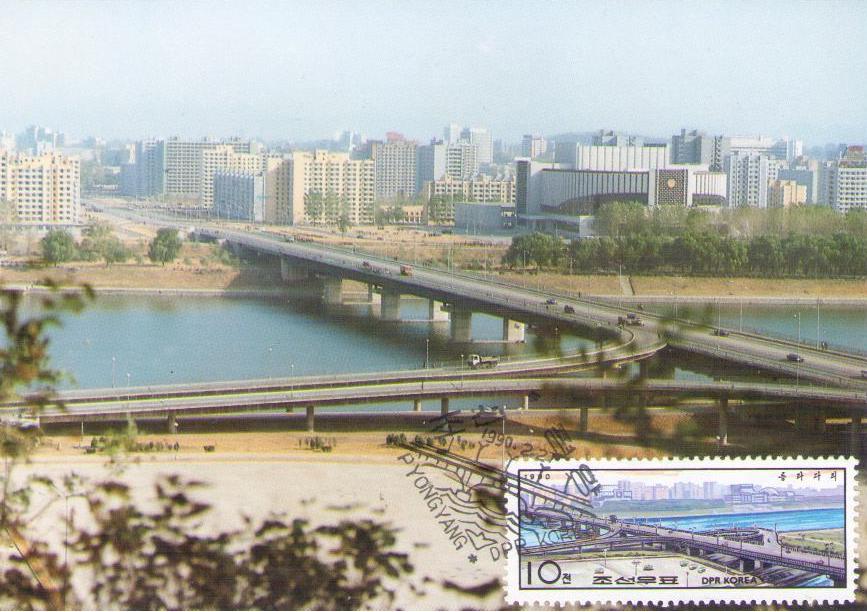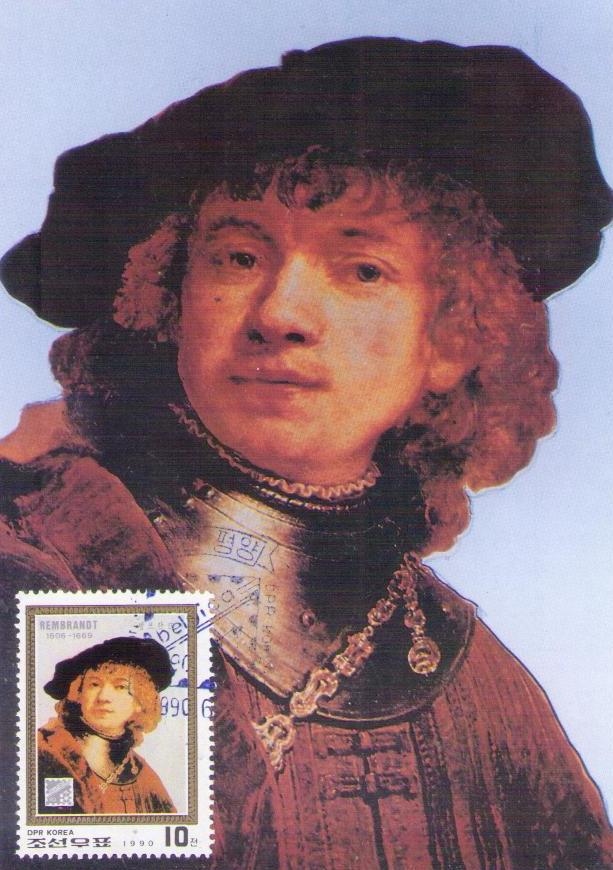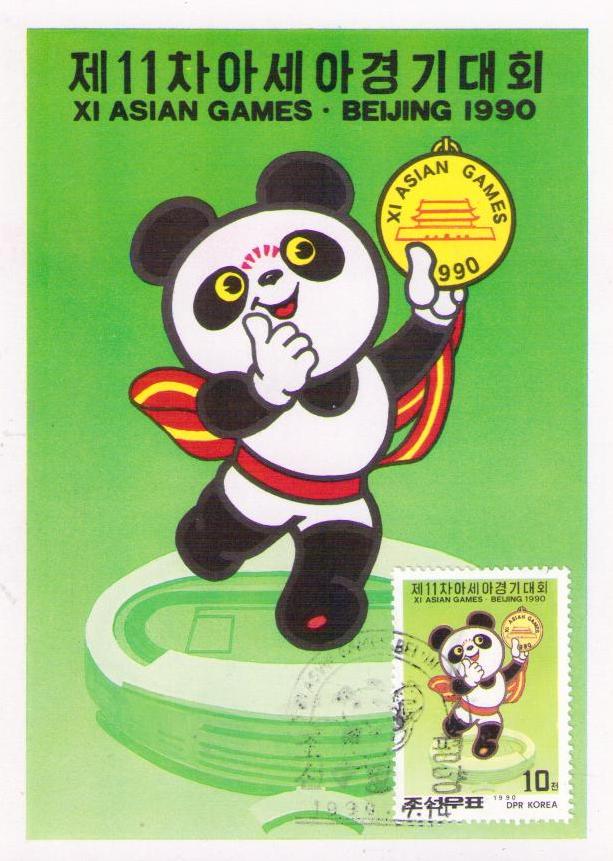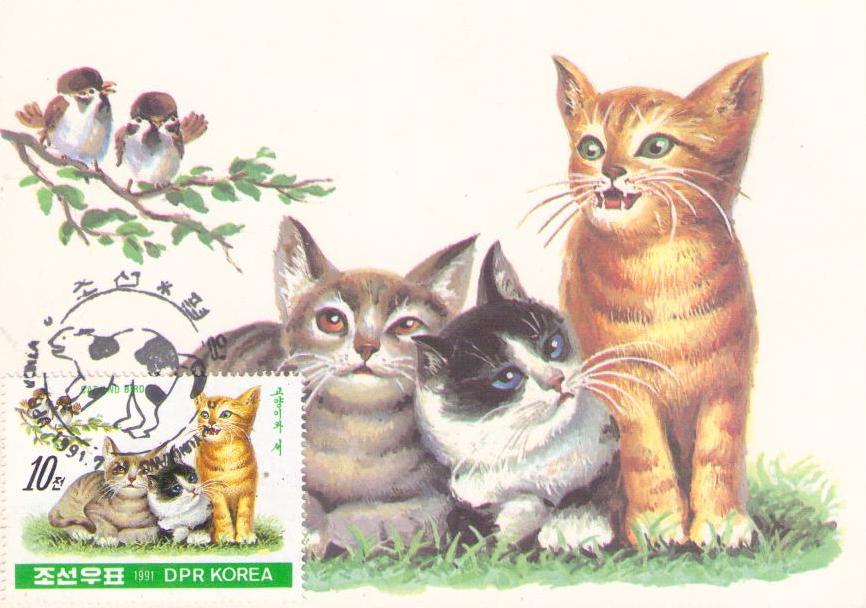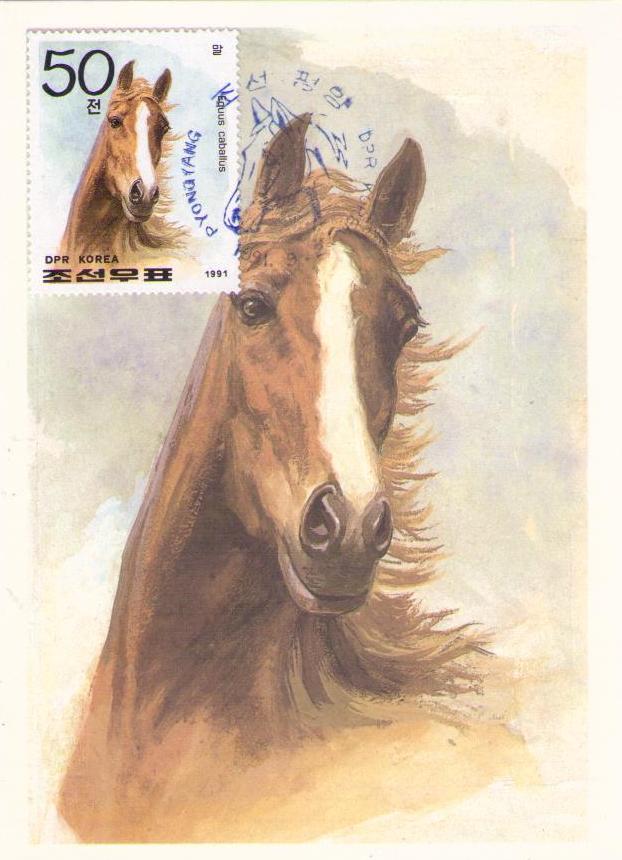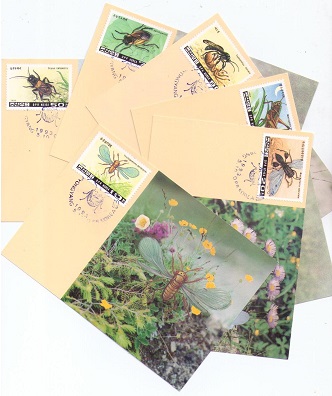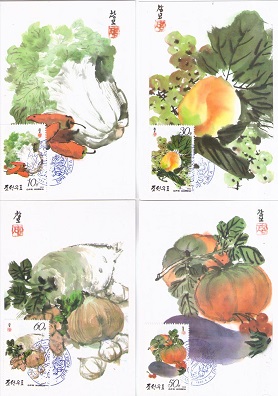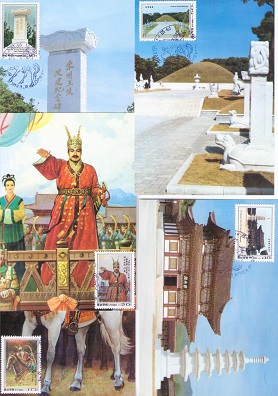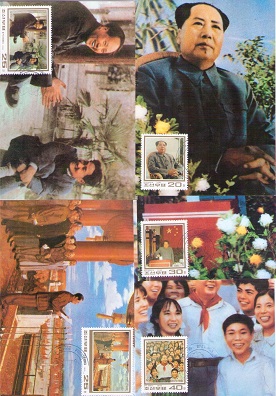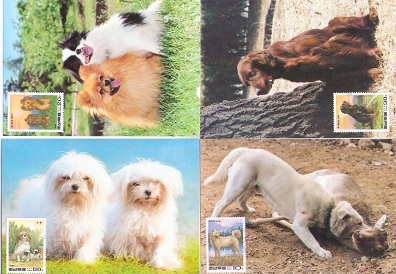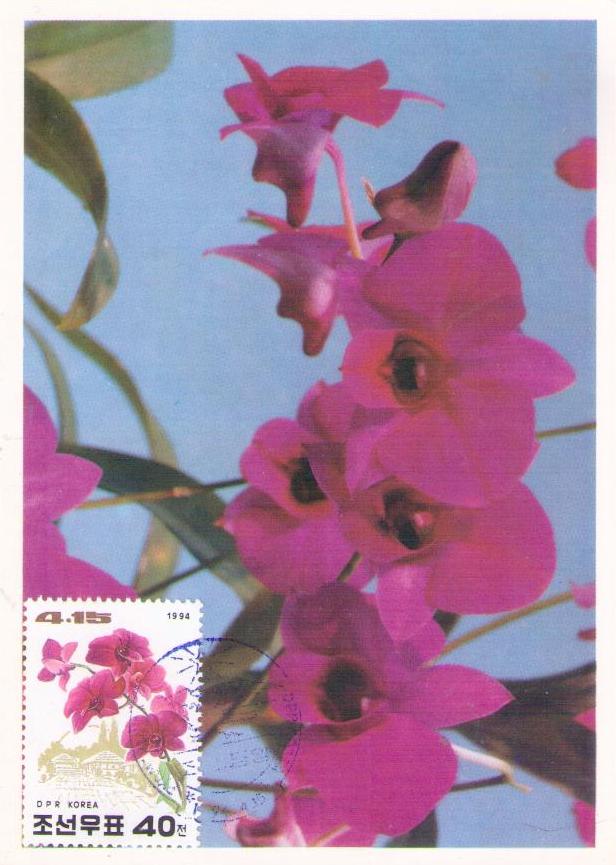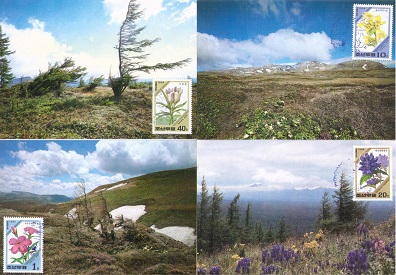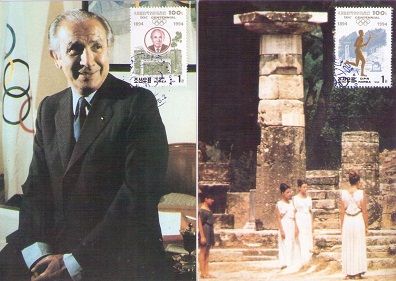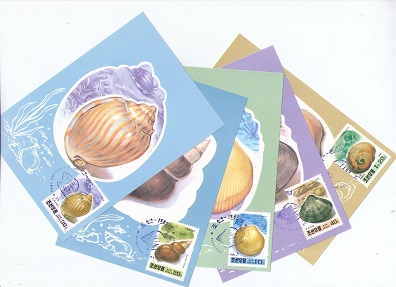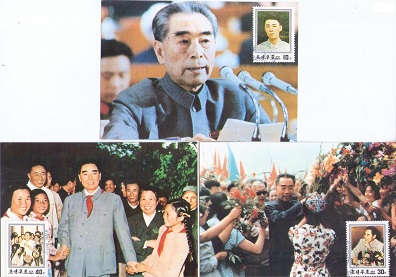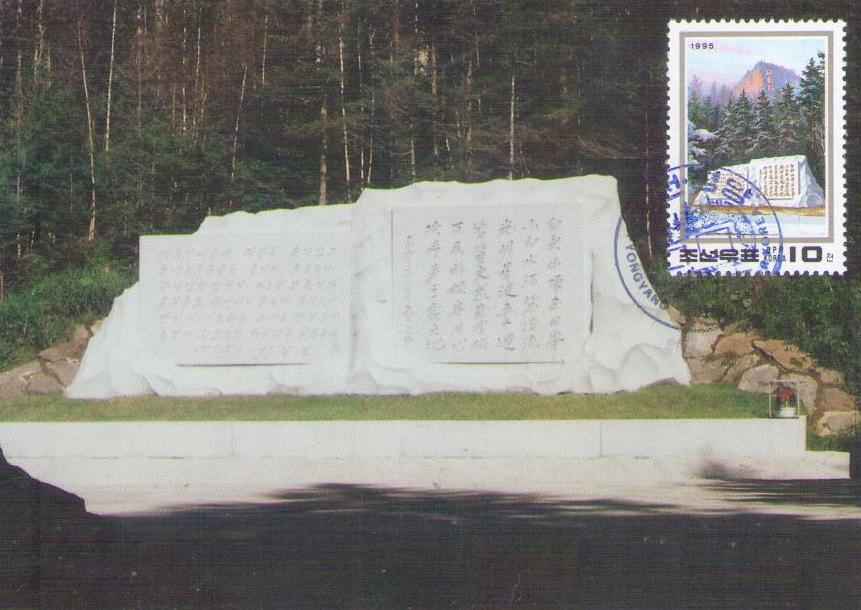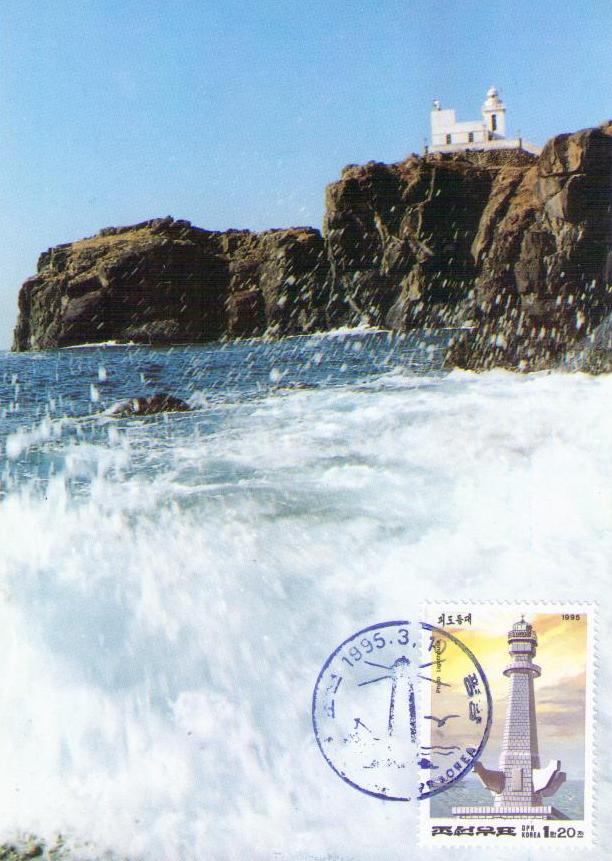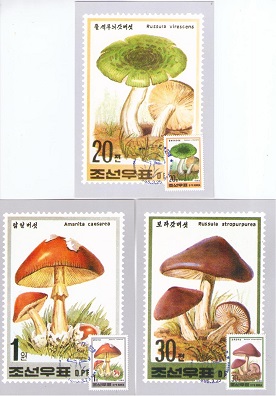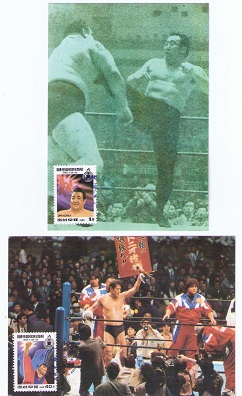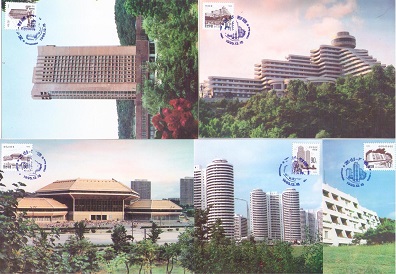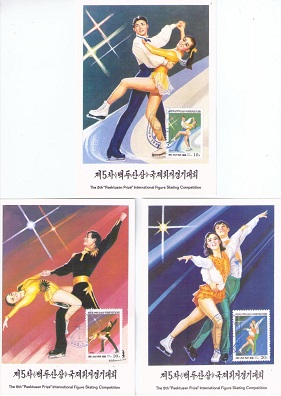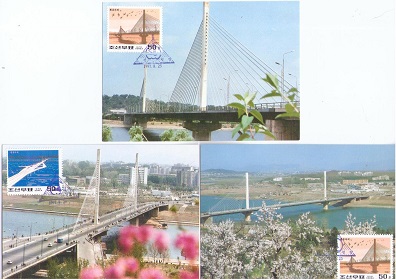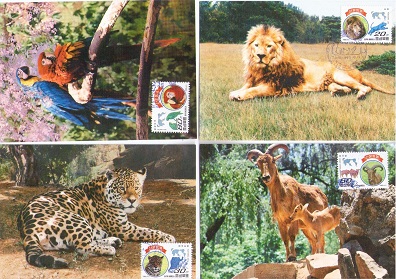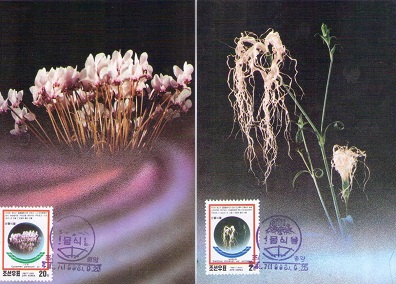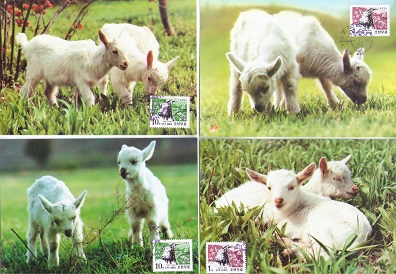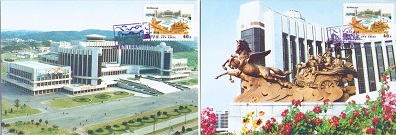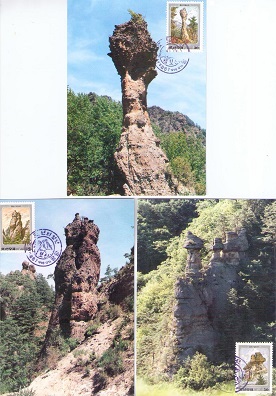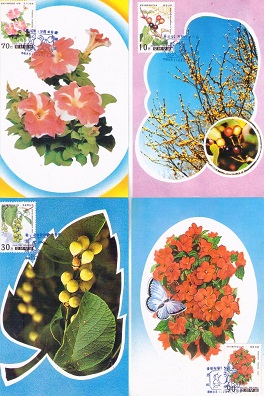-
Mandarin ducks (group of 4) (Maximum Cards)
From 1987, with slightly flawed postmarks (note what should be “WWF”) , this set of four unused maximum cards all showing Aix galericulata and captioned in both Korean and the scientific name. Grades: 1
-
500th Anniversary of Columbus’ America Discovery (Maximum Card)
Arguably an odd choice for DPRK to issue, nonetheless here it is, a maximum card from 1988 with no Korean language at all (except on the stamp) and everything else extensively in English. The postmark is indistinct, and there is some postmark ink transfer on the reverse. Grade: 2
-
Soviet astronauts (set of 2) (Maximum Cards)
Issued in 1988, two maximum cards, one (with Yuri Gagarin on the stamp) captioned “Spaceship” in English and Korean, and the other (with Valentina Tereshkova) captioned “Work in space” in English, and Korean. Grade: 1
-
13th World Festival of Youth and Students (set of 2) (Maximum Cards)
Colourful set of two maximum cards from 1989, of the event held in Pyongyang. Captioned entirely in English. Grade: 1
-
Saturn (Maximum Card)
Unused 1989 maximum card in English and Korean. Just as a side thought, what’s up with having a black postmark on a black background? Don’t hope for much visibility there. Grade: 1
-
Brasiliana-89 (set of 2) (Maximum Cards)
Set of two maximum cards from 1989, called Brasiliana-89 but both featuring Pele. One is his performance in the World Football Championship in 1970. Captioned in Korean and English. Grade: 1
-
Flowers (set of 6) (Maximum Cards)
Six maximum cards from 1989. They are captioned in Korean and with the scientific names. Our scan shows at least the stamped part of each card, and to compensate for not showing all of the photos, we will give you all of those names: Tulipa gesneriana, Anthurium andreanum, Clivia miniata, Gerbera hybrida, Narcissus pseudonarcissus, and Rhododendron obtusum. We like the name “Narcissus pseudonarcissus,” as if it couldn’t decide what it wanted to be: it’s a wild daffodil. Grade: 1
-
Pyongyang, Rungra Bridge (Maximum Card)
Unused maximum card from 1990. Captions in English and Korean. Grade: 1
-
Rembrandt (Maximum Card)
Unused 1990 maximum card, captioned in Korean and English. Grade: 1
-
XI Asian Games – Beijing 1990 (Maximum Card)
Unused 1990 maximum card, with no other special caption apart from Pyongyang attribution. Grade: 1
-
Brontosaurus (Maximum Card)
Unused 1991 maximum card captioned “Mesozoic Animal (Brontosaurus)” in English, and in Korean. Grade: 1
-
Cats and birds (Maximum Card)
Unused 1991 maximum card No. 105275 whose Korean-only caption (고 양 이 와 새) translates as: “And the amount of new,” which is not too helpful. But judging from the look on that orange cat’s face, the amount of birds may soon decrease by at least one. Grade: 1
-
Equus caballus (Maximum Card)
Unused maximum card No. 105278 from 1991, captioned as “Horse” in Korean, and “Equus caballus” otherwise. Grade: 1
-
Insects (set of 6) (Maximum Cards)
If you are into entomology, how can you not love this 1993 set of six maximum cards? The scan gives you the idea of what they look like, and the captions are in Korean and the scientific names: Trichogramma dendrolimi, Gryllus campestris, Geocoris pallidipennis, Cyphononyx dorsalis, Metrioptera brachyptera, and Brachymeria obscurata. (We did that both for you and for the search engines.) Grade: 1
-
Fruits and vegetables (set of 6) (Maximum Cards)
The scan shows four of the six maximum cards in this set, to give you the idea. Unused, from 1993, and identically captioned in Korean and English (“Fruits and Vegetables”). Grade: 1
-
Monument to the Victory (set of 3) (Maximum Cards)
Set of three unused maximum cards from 1993. Captioned in English and Korean, one of these cards says “Monument to the victory in the Fatherland Liberation War ‘Defenders of the Height 1,211′”. The other two have similar themes. Grade: 1
-
King Tongmyong (set of 5) (Maximum Cards)
Set of five maximum cards from 1993, of which you can see at least the stamped part of all five in the scan. The caption on one says “King Tongmyong (Ko Ju Mong), the Founder of Koguryo entering the castle (Mural painting)” and the others have a similar idea. Grade: 1
-
Mao Zedong (sic) (set of 5) (Maximum Cards)
The scan shows all or part of the five maximum cards in this 1993 set, various scenes of Chairman Mao’s activities. (We should not need to remind you that Chairman Mao was from China, not Korea, but we will remind you anyway.) Grade: 1
-
Dogs (set of 5) (Maximum Cards)
Excuse us while we say more than usual here. First, this is a set of five maximum cards from 1994. The postmarks are (too) faint. Our scan shows four of the five cards; the fifth is of a group of five dogs sitting and looking like they are dozing in the sun. Four of the five cards are captioned “dog” in Korean and English. The fifth card–which is the one on the lower right side of the scan–is captioned “Phungsan dog” (풍 산 개) in addition, possibly to compensate for the gory scene taking place. Phungsan translates as “wind mountain”, and as a side note, the name sounds about the same in Cantonese and Korean. Enough! Grade: 1
-
Kimilsungia (Maximum Card)
Have you been searching for a Kimilsungia postcard? This one’s for you. Unused maximum card from 1994, captioned in Korean and then the flower’s name in western letters. Grade: 1
-
Nature (set of 6) (Maximum Cards)
“Nature” in this case means a set of six maximum cards from 1994, of which four appear in the scan. All are captioned in Korean and with the scientific names of the respective foliage, which–if you would like to know–are: Chrysosplenium sphaerospermum, Campanula cephalotes, Dianthus repens, Gentiana algida, Sedum kamtschaticum, and Trollius macropetalus. (Why do we do this? Two reasons: someone might really want to know, and we need all the search engine visibility we can get for this website.) Grade: 1
-
Olympics (set of 2) (Maximum Cards)
Two seemingly unrelated unused maximum cards from 1994, though they do commemorate the 100th IOC Centennial. One shows the Tower of Signal-fire of the 1st International Olympic Games, and the other shows J.A. Samaranch, chairman of the International Olympic Committee. Captioned in Korean and English. Grade: 1
-
Shells (set of 5) (Maximum Cards)
Once again, five maximum cards from 1994, captioned in Korean and with the scientific names: Neverita didyma, Gomphina veneriformis, Cardium muticum, Buccinum bayani, and Phalium strigatum. Grade: 1
-
Zhou Enlai (set of 3) (Maximum Cards)
Set of three maximum cards from 1994, captioned in Korean and English (why not also in Chinese?) Grade: 1
-
The immortal Ode Monument (Maximum Card)
Unused 1995 maximum card, with Korean and English captions. Grade: 1
-
King Tangun (set of 4) (Maximum Cards)
Set of four maximum cards from 1995, with various aspects of King Tangun. Captions in Korean and English. Grade: 1
-
Lighthouse (Maximum Card)
Stand-alone unused maximum card from 1995, captioned only “Lighthouse” in Korean and English. Grade: 1
-
Mushrooms (set of 3) (Maximum Cards)
Set of three maximum cards from 1995, captioned in Korean and with the scientific names: Amanita caesarea, Russula atropurpurea, and Russula virescens. Somehow, it’s reassuring to be able to tell you that all three varieties are edible. We think. Grade: 1
-
Sports Festival (set of 2) (Maximum Cards)
Set of two maximum cards from 1995. Both are captioned in Korean and English. The coloured card says “The Pyongyang International Sports and Cultural Festival for Peace” (and no better way to portray that than through wrestling), while the other shows Ryok To San, a legendary DPRK champion. Grade: 1
-
Party Founding (set of 3) (Maximum Cards)
A set of three maximum cards from 1995. Captions in Korean and English, and we’ll give the English to you: The Monument to Party Founding; The sculptural group of three persons of the Tower of Juche Idea; and The Party Founding Museum. Grade: 1
-
Pyongyang buildings (set of 5) (Maximum Cards)
All or part of each of the five maximum cards in this set are visible in the scan. The buildings are readily identifiable through Korean-only captions. Grade: 1
-
Paektusan Prize (set of 3) (Maximum Cards)
A set of three 1996 maximum cards representing the 5th “Paektusan Prize” International Figure Skating Competition. There are no special captions on the reverses, just a reference number ㄱ-507101. Grade: 1
-
Bridges (set of 3) (Maximum Cards)
Set of three maximum cards from 1997. Two are captioned only in Korean, and the third (Rungra Suspension Bridge) in both Korean and English. Grade: 1
-
Kumgang, Podok Hermitage (Maximum Card)
Unused 2003 maximum card, captioned only in Korean. It’s really a large stamp. An official website says “situated in the delightful Manphok Valley of Inner Kumgang, the buildings were constructed in 1675 during the Ri Dynasty.” Grade: 1
-
Animals (set of 4) (Maximum Cards)
A set of four unused maximum cards from 1997. Captions are only in Korean. Grade: 1
-
Plants (set of 2) (Maximum Cards)
This set of two 1998 maximum cards has extensive Korean-language captions, and scientific names are in the fine print on the stamps. Grade: 1
-
Goats (set of 4) (Maximum Cards)
This is a set of four maximum cards from 1998. Captioned identically in Korean, something really goes wrong when we try to translate that, so we’ll leave it to you. (The last part does say “Goats”, though.) Grade: 1
-
Mangyongdae (set of 2) (Maximum Cards)
Here’s a set of two maximum cards from 1998. Postmarking was done so heavily that it bled through to the reverse. Korean-language captions only. Should be Grade 1, but we’ll conservatively call these Grade: 2
-
Mt. Chilbo (set of 3) (Maximum Cards)
Unused set of three maximum cards from 1998. Captions are all in Korean. Grade: 1
-
Botanical (set of 4) (Maximum Cards)
Set of four maximum cards from 1999. Though captions are only in Korean, the scientific names are in Roman lettering on the stamps. This time, we’ll leave that research to you. Grade: 1

